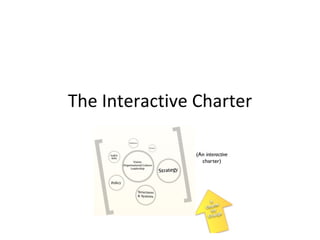The Interactive Charter
- 2. The story so far..... Weâve identified a need for a step-change â a toolkit for people who want to make their organisation more interactive There are enough people who are convinced of the business case for interactivity and who are willing to articulate it in a persuasive way We know what a lot of the obstacles are We believe that there are people in leadership roles that would be willing to remove these obstacles â if they believe that it is possible
- 3. Thereâs a wiki listing 50 hurdles to interactivity http://www.practicalparticipation.co.uk/socialstrategy/
- 4. About 50 people helped us refine it
- 5. And weâre now working with those people to author âThe Interactive Charterâ www.interactivecharter.org
- 6. Charter Commitments (draft) The organisation signing the charter: recognises the business case for interactivity commits itself to removing the â50 hurdlesâ agrees to publish a target date for the removal of each hurdle agrees to publish a progress chart showing how far they have got towards the removal of each hurdle
- 7. Why a charter? A charter can include a commitment that someone at a leadership level can sign up to on behalf of their organisation It can also be signed by individuals who would like the organisations around them to commit to the principles of openness and interactivity embodied in the charter Helps social-web advocates understand the organisational issues
- 8. What does the charter commit an organisation to do?
- 10. Co-ordination This should be a collaborative process â not an adversarial one. More âcarrotâ than âstickâ â no publicity until successfully completed Consistency of definitions is important A private community network sharing experiences, anecdotes and resources should be established among participating organisations Wider learning is an incidental benefit The final output should be a published âtoolkitâ â a briefing of the implications of signing the charter for different professional groupings (i.e. Implications for Childrenâs Services etc)
- 11. Where next? We need to complete the charter and get individual signatories; Once weâve done that, we need between 10 - 20 organisations to sign up the charter and pilot the charter process; We want a mix (local government, fire, police etc) We will provide consultancy and support to these organisations as part of an action research process; Through this action research we further develop the list of hurdles and build up shared learning on approaches for overcoming them in different contexts; We share this learning in a published toolkit, and as the basis for a scalable consultancy and capacity building offer;Â
- 12. Push the start button Possible sponsors A single national institutional sponsor? A few joint sponsors? Individual signatories contribute to a project-management fee? A few regional bodies share the costs? Ready?
- 13. YOU CAN SIGN UP *NOW* AS AN INDIVIDUAL... WHAT ARE YOU WAITING FOR? "I believe in interactive organisations and support the Interactive Charter as a statement of positive change. I will encourage organisations I am working with to adopt the Charter and to remove the barriers to effectively use of social media."Â
- 14. LET US KNOW WHAT YOU THINK? Tim Davies Paul Evans Warren Hatter














